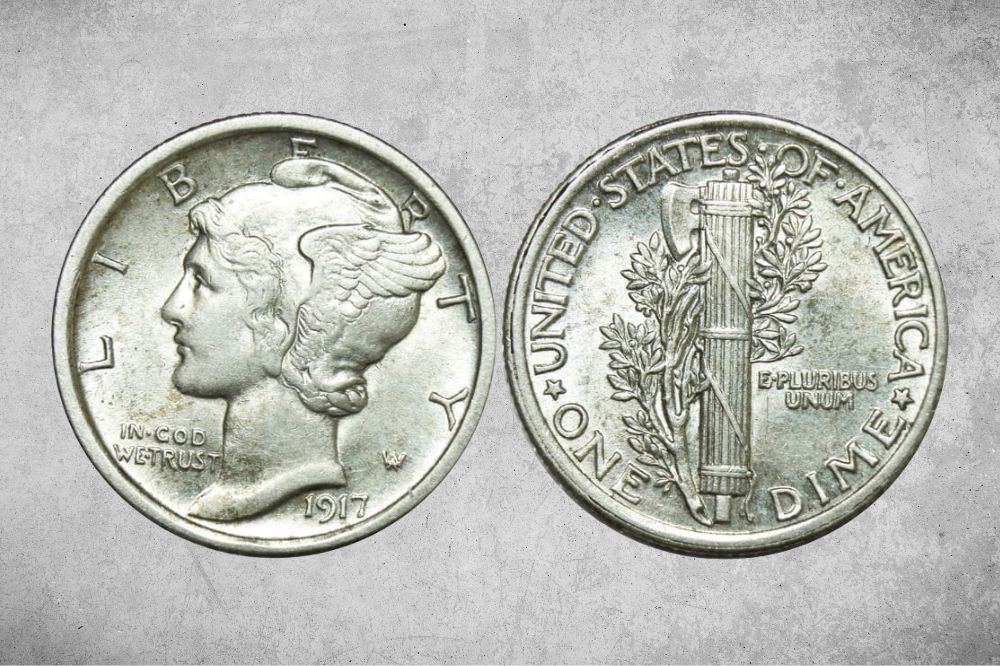Have you ever seen a 1917 dime at your local store and become curious about its worth? Do you regularly wonder whether collecting 1917 dimes is worth it? If so, we have some answers for you in this post.
In it, we are going to do a deep dive into the 1917 dime value, its key features, history, and common errors.
1917 Dime Details
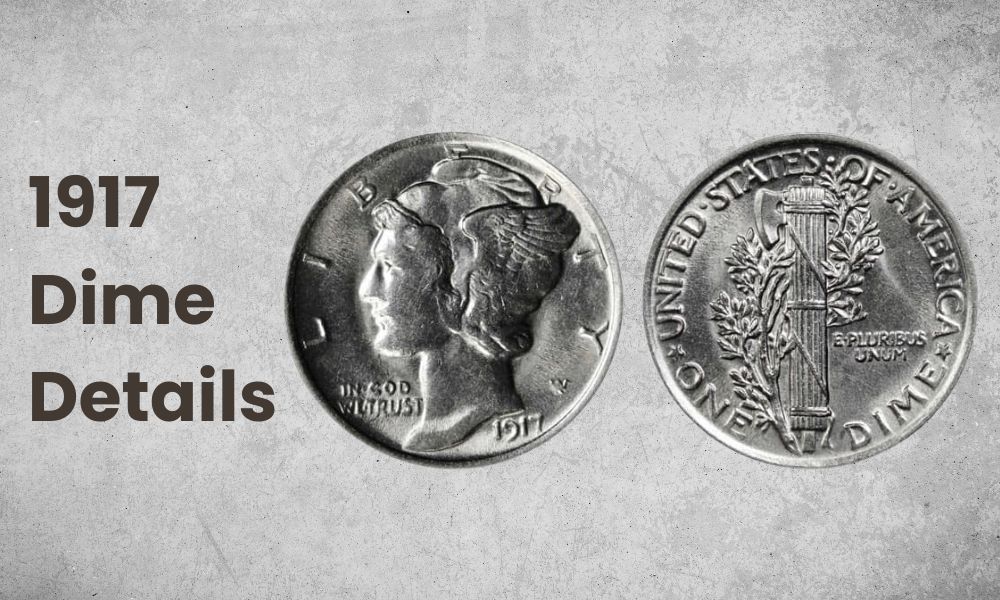
- Category: Mercury Dimes
- Total Mintage: 91,962,000
- Minting place: Philadelphia, Denver, San Francisco
- Diameter: 17.9 mm
- Weight: 2.5 g
- Edge: Reeded
- Face value: $0.10 (10 cents)
- Composition: 10% copper and 90% silver
- Engraver: Adolph Alexander Weinman
The Obverse Design of the 1917 Dime
The obverse of the 1917 design bears the image of Lady Liberty facing left. In the image, she is wearing a winged Phrygian Cap. This is why this dime is commonly referred to as the winged Liberty head dime.
It is also called the Mercury dime because the lady Liberty image also resembles Hermes/Mercury. This is not the only thing that’s on the obverse’s design though.
There’s also a “LIBERTY” inscription running around the top edge of the coin; a part of the letters E and R is hidden behind the cap. The inscription starts from the left side of the coin near Lady Liberty’s mouth to the right side at the back of her head.
On the lower left side under Liberty’s chin are the words, “IN GOD WE TRUST.” Also, 1917 is inscribed at the right bottom of the coin, just below Liberty’s neck. A little above this inscription to the right edge of the coin are the initials AW.
These are the initials of the coin’s designer, Adolph Alexander Weinman.
The Reverse Design of the 1917 Dime
The reverse side of the 1917 dime has the words, “UNITED STATES OF AMERICA” written along its top edge. The words are separated with dots and there is a star before the first word and another one after the last word.
Beyond that, the words “ONE DIME” are written along the lower edge of the coin. Between the two words is a fasces with an olive branch wrapped around it using 3 twin bands. A fasces is a bundle of sticks with a protruding ax blade.
While the fasces is an Italian symbol of a magistrate’s authority, it symbolizes the United States’ peace policy in this case. In the reverse design of the 1917 dime, the featured fasces is placed vertically in the middle.
It starts from below the top inscription and ends between the bottom one. The blade of the fasces and most of the olive branch is on the left side.
There are a few leaves of the olive branch on the top right side of the coin and under them is the US motto “E PLURIBUS UNUM.”
Other Features of the 1917 Dime
Design aside, the 1917 dime has a host of other interesting features. For one, it has a composition of 90% silver and 10% copper. Also, it’s small and light; it has a diameter of 17.9 mm, a thickness of 1.35 mm, and a weight of 2.5 g.
Another interesting feature of the 1917 dime is that it has 118 reeds along its edge.
Also Read: Top 15 Most Valuable Indian Head Penny Worth Money
1917 Dime Value Chart
| 1917 Dime Value Chart | ||||
| Type | Good | Fine | Extremely Fine | Uncirculated |
| 1917 No Mint Mark Dime | $1.51 | $1.82 | $3.72 | $24 |
| 1917 “S” Dime | $1.51 | $2.15 | $14 | $72 |
| 1917 “D” Dime | $2.15 | $13 | $40 | $149 |
1917 Dime Values and Varieties Guide
1917 No Mint Mark Dime
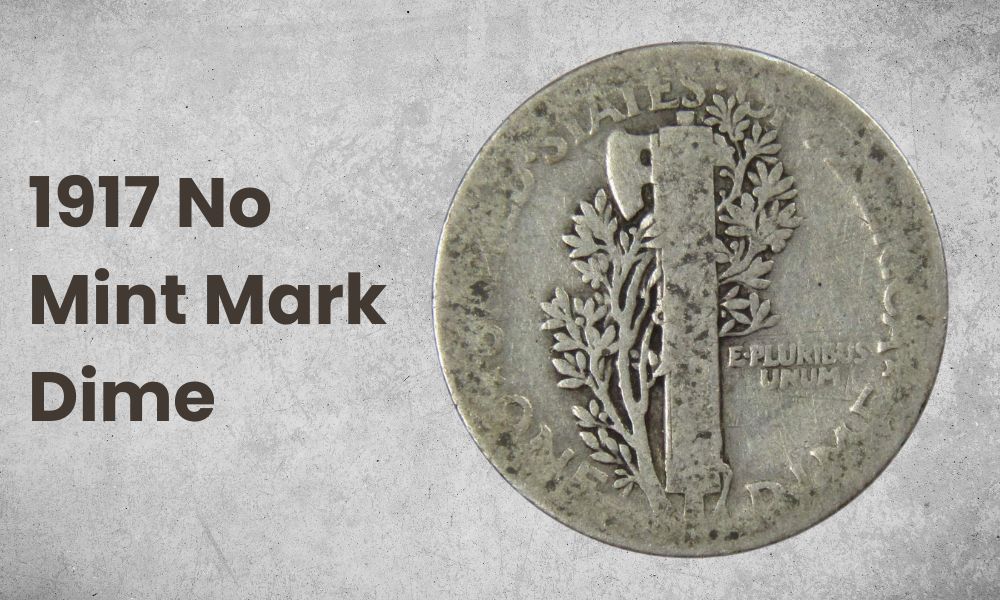
- Type: Mercury Dime
- Mint: None
- Minting place: Philadelphia
- Year: 1917
- Edge: Reeded
- Mintage: 55,230,000
- Designer: Adolph Alexander Weinman
- Face value: $0.10
- Current value: $1.51 to $24
- %Composition: 90% silver and 10% copper
- Mass: 2.5 g
- Diameter: 17.9 mm
In 1917, the Philadelphia mint produced 55,230,000 no-mint mercury dimes. Today, these coins usually cost an average of $1.51 to $24. Generally, the better condition they are in, the more expensive they are.
As such a 1917 no-mint dime that has a grade of MS60 or above can cost $50 to $500. An MS66+ can even go for $660 in some cases. Another thing that influences the value of 1917 dimes is how well you can see their details.
For instance, the term “Full Band” can be used to describe dimes that clearly show the middle split in the center band holding the olive branch and fasces together. This is an indication that the coins were sharply struck.
Ultimately, this feature makes 1917 no-mint dimes more valuable. A PCGS MS67+ full band no-mint 1917 dime can cost as much as $7,050.
1917 “S” Dime
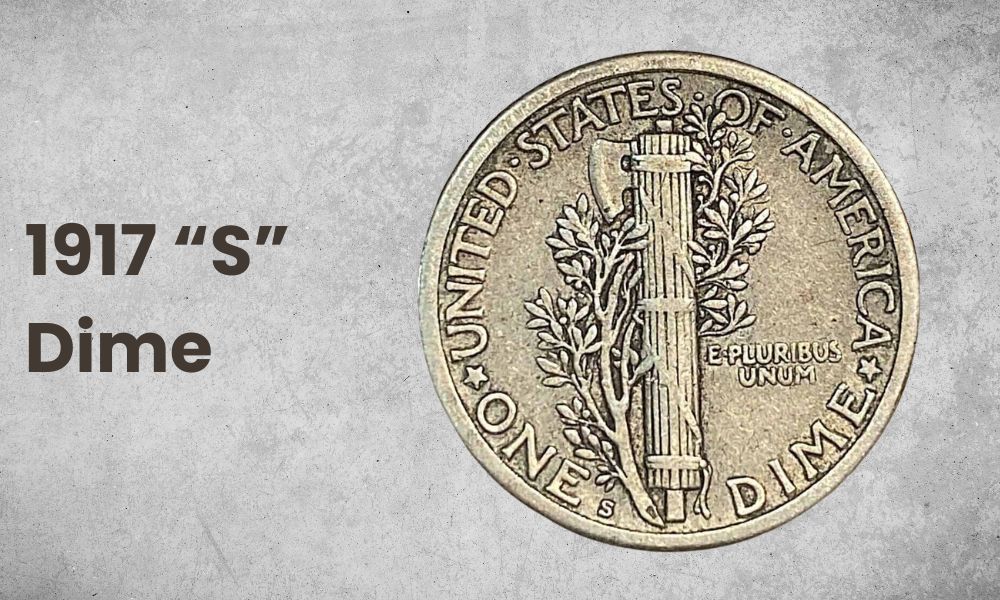
- Type: Mercury Dime
- Mint: “S”
- Minting place: San Francisco
- Year: 1917
- Edge: Reeded
- Mintage: 27,330,000
- Designer: Adolph Alexander Weinman
- Face value: $0.10
- Current value: $1.51 to $72
- %Composition: 90% silver and 10% copper
- Mass: 2.5 g
- Diameter: 17.9 mm
The San Francisco mint produced 27,330,000 mercury dimes in 1917. They each had a small “S” mark after the word “ONE” on their reverse sides. Interestingly, this was the highest mintage of S-type mercury dimes before the year 1941.
This has contributed to this coin being available in circulated states to this date. However, since fewer 1917 S dimes were minted than their no-mint counterparts, they are rarer and more expensive. Mint-state samples are particularly hard to find.
So while an average-grade 1917 S dime can cost you $1.51 to $72, a mint-state one can go for up to $3, 450. A full-band MS67 is even more expensive; it can go for as high as $7,200.
1917 “D” Dime
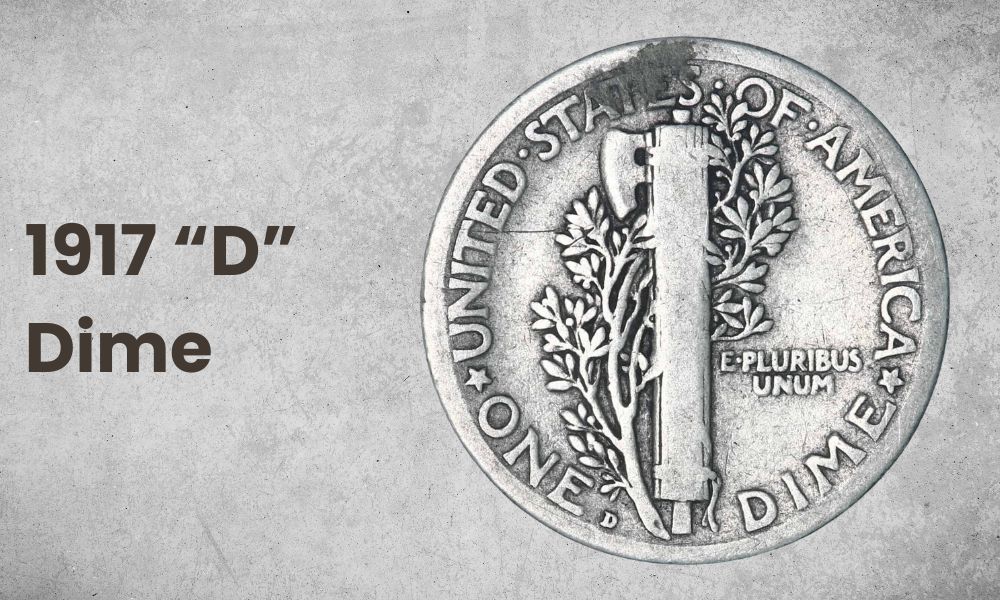
- Type: Mercury Dime
- Mint: “D”
- Minting place: Denver
- Year: 1917
- Edge: Reeded
- Mintage: 9,402,000
- Designer: Adolph Alexander Weinman
- Face value: $0.10
- Current value: $2.15 to $149
- %Composition: 90% silver and 10% copper
- Mass: 2.5 g
- Diameter: 17.9 mm
The Denver mint produced 9,402,000 mercury dimes in 1917. They each had a small “D” mark after the word “ONE” on their reverse sides. Because they are fewer than their Philadelphia and San Francisco counterparts, these dimes are rarer now.
As such, average pieces go for higher rates of around $2.15 to $149. Mint-state examples go for even higher; an MS67 can cost you $7,800. A full-band MS67 can cost you a whopping $30,550.
Also Read: Top 15 Most Valuable Roosevelt Dimes Worth Money
1917 Dime History
The mercury dime was first minted in late 1916. Adolph Alexander Weinman designed it to replace the Barber dime. The latter had been in use since 1892. It was designed by Charles Barber, the chief engraver of the mint at the time.
Since it has been in use for 25 years and could now be switched without needing approval from Congress, a competition was held to come up with new designs. Both Barber and Weinman participated in the competition but the latter’s designs won.
While Barber was not happy about this, he had no choice but to help in the minting of the new dimes. During this time, there was a lot of speculation about whose face Weinman used in the Lady Liberty image.
Some even suggested that it was Elsie Stevens, a woman whose bust Weinman sculpted in 1913. But Weinman never acknowledged this. Fortunately, this didn’t affect the dime’s reception when it was finally released on October 30th, 1916.
As Barber had died in February of the same year, his successor George Morgan was in charge of releasing these new coins. He ensured that the dimes were minted in the Philadelphia, San Francisco, and Denver facilities.
Ultimately, the mercury dime continued to be produced every year until 1945 when the Roosevelt dime replaced it. This new dime was designed in honor of the United States’ 26th President Theodore Roosevelt who passed away in 1919; it’s still used today.
1917 Dime Grading
Like other coins, the 1917 dime is graded on a scale of 1 to 70 and categorized into groups like good, fine, extremely fine, and uncirculated. Beyond that, the higher-grade dimes can also be graded depending on whether they are full-band or not.
This is similar to how some pennies can further be graded based on their colors. However, only grading agencies like PCGS and NGC use such additional parameters.
List of 1917 Dime Errors
1. 1917 Dime Uncentered Broadstrike
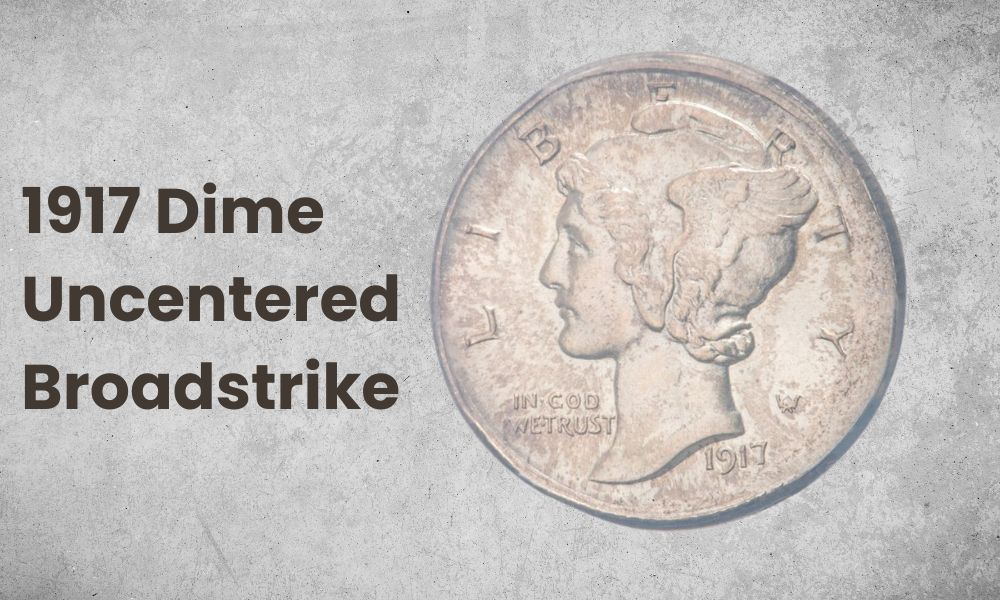
This is an error that occurs when the design is struck on the coin without being centered. When this error occurs, you will notice that the design on each side of the coin is moved toward the one although it’s all there.
This error makes a 1917 dime more valuable. For instance, it made the price of a PCGS AU55 no-mint mark 1917 dime come to around $200. A similar dime with a grading of NGC MS63 full band also sold for a higher price; around $700.
2. 1917 Dime Off-center Strike
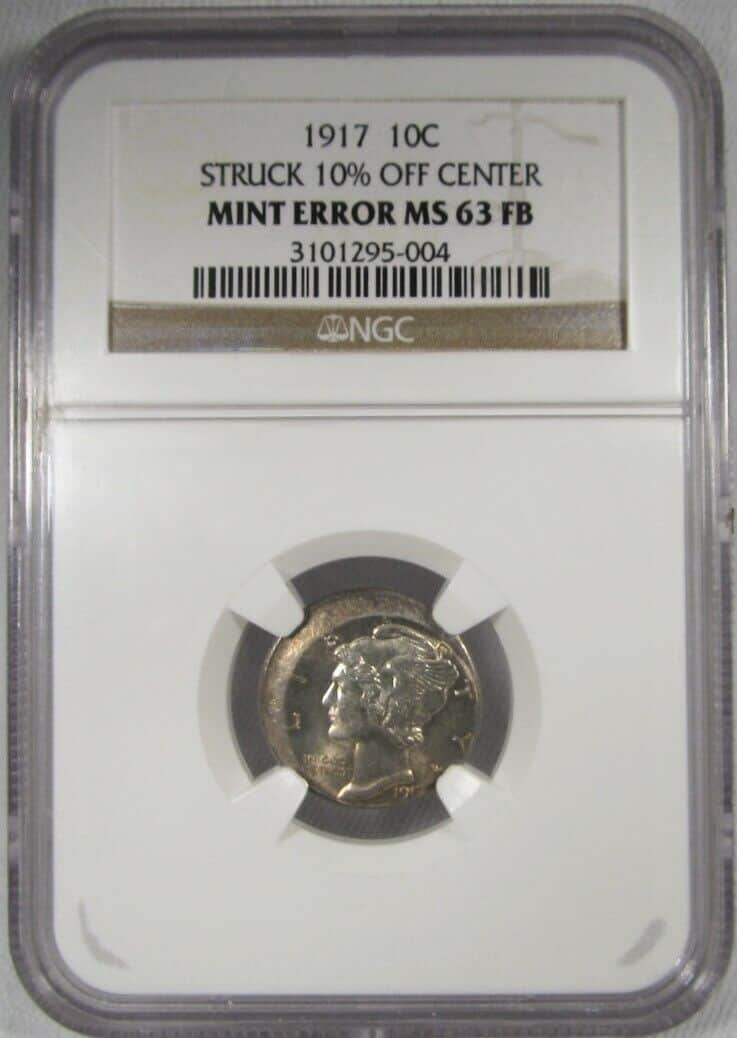
This error is similar to the broad strike in that it occurs when striking is done without centering the design. However, in the off-center strike, some of the design doesn’t show up on the coin.
As such, you’ll notice that coins having this error will be labeled with the percentage by which the design has shifted. This can make a coin more valuable. That’s why a PCGS AU50 1917 S dime that was struck 15% off-center sold for over $320.
Another coin, a PCGS AU58 no-mint 1917 dime that was struck 25% off-center, sold for over $485.
3. 1917 Dime Double Clip
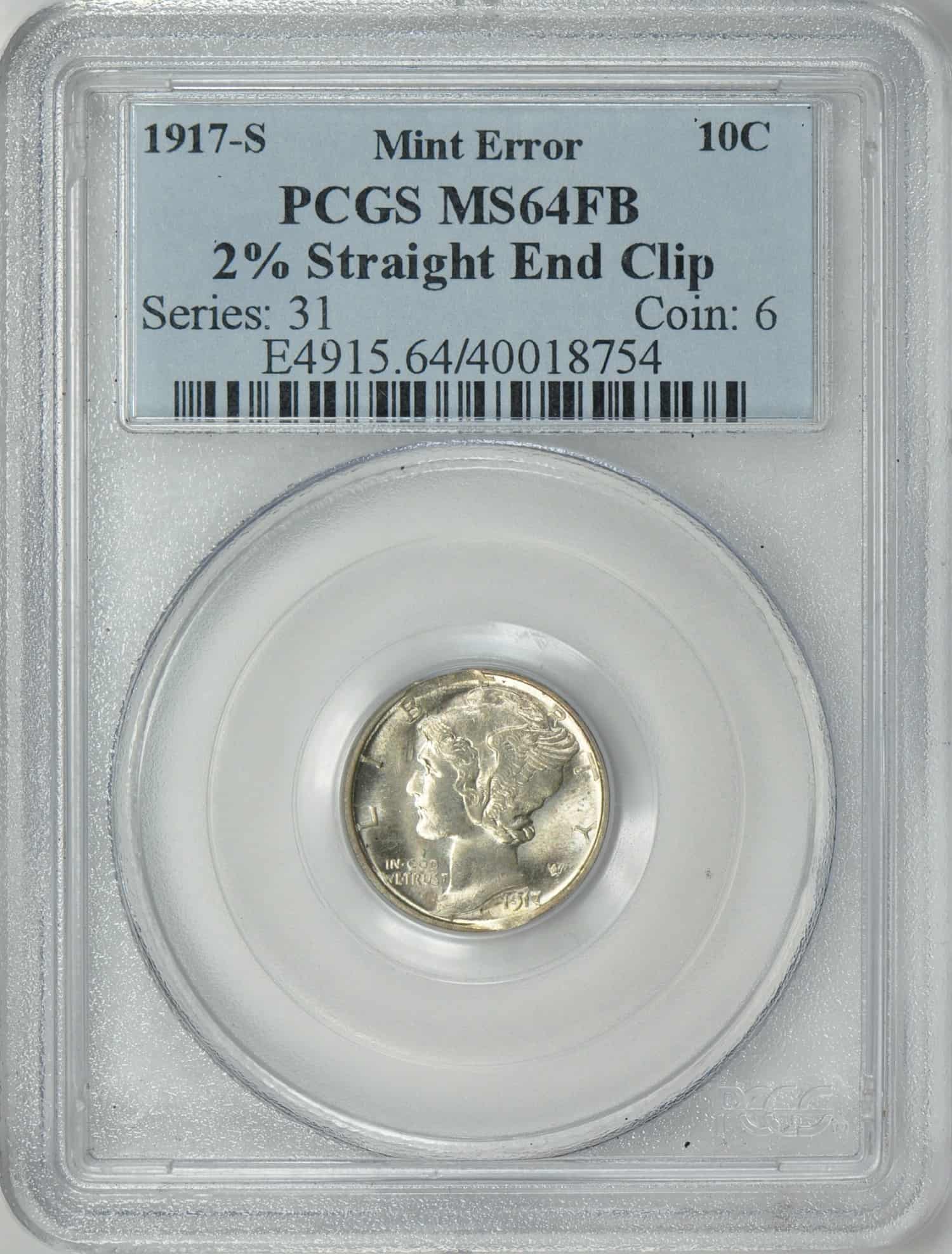
A curved clip error is evidenced by curved-out areas of the coin. It is the result of an overlap between blanking dies and a blank that has already been punched out. It happens when a created black isn’t pushed out of the way fast enough.
When a coin has two clip errors, it’s said to have a double clip. This can increase the value of the coin, especially when it’s combined with other errors.
It’s therefore not surprising that an ANACS MS60 1917 no-mint dime with both a double clip and broad strike ended up selling for around $230.
1917 Dime FAQ
How much is a 1917 silver dime worth today?
A 1917 dime will cost you at least $1.51. High-grade examples with full bands and some errors can go for as high as $30,550.
What mercury dime is rare?
The rarest mercury dimes are the 1926 S, 1925 D, 1931 D, 1942 over 41, 1942 over 41 D, 1921 D, 1921 no-mint, and 1916 D. However, you can still find these coins in low grades; you can even find a few in high grades.
What mercury dime is worth a lot of money?
While the 1938 S dime is not the rarest mercury dime, one of its pieces broke the price record at a 2019 auction. The PCGS MS68+ full band piece went for a whopping $364,250.
What year dimes are silver?
All the US dimes produced before 1965 had 90% silver. These include the Draped bust dimes (1796 to 1807), Capped bust dimes (1809 to 1837), Liberty seated dimes (1837 to 1891), Barber dimes (1892 to 1916), and mercury dimes (1916 to 1945).
Even the Roosevelt dimes (1946 to date) were originally made of 90% silver and 10% copper. This changed in 1965 when the mint started using 75% copper and 25% nickel. This wasn’t the end of silver being used for dimes though.
From 1992 to 2008, the mint used 90% silver to make proof dimes. These were handed out in special silver proof sets. From 2019 to date, the mint has been issuing these proof sets again, this time with coins made of 99% silver.
How can you tell if a dime is silver?
The best way to figure out whether a dime is silver is to check the date on it. If you can’t do this, your best bet is to go see a bullion dealer or numismatist who can test the coin for silver.
